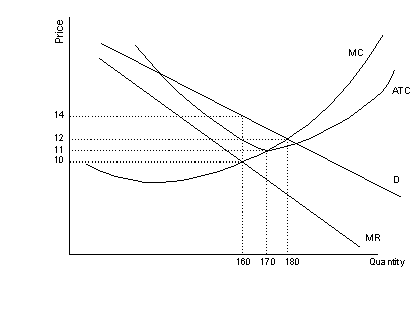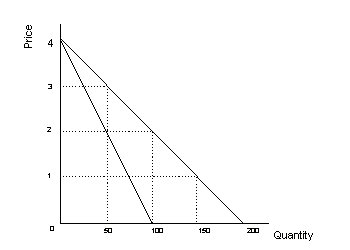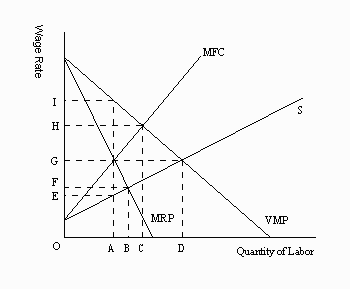Economics 165 Final Exam
Fall 1997
- 1. Opportunity cost can be defined as
- a. the highest-valued alternative that had to be
sacrificed for the option that was chosen
- b. the lowest-valued alternative that had to be
sacrificed for the option that was chosen
- c. the time involved in the production of an economic
good
- d. the money cost of an economic good
- 2. Economic models or theories
- a. are limited to variables that are directly
(positively) related
- b. are simplifications of the real world they represent
- c. cannot be tested empirically
- d. are limited to variables that are inversely related
- 3. On a production possibilities frontier, the optimum or
best combination of output is
- a. at the precise midpoint of the frontier
- b. at a point near the bottom of the frontier
- c. at a point near the top of the frontier
- d. at a point near the middle of the frontier
- e. impossible to determine since this is a value judgment
to be made by society
- 4. Assuming an economy to be operating at a point inside
the production possibilities frontier, one may conclude
that:
- a. unemployment of resources or technological
inefficiency exists
- b. the economy is a free market economy
- c. the economy is at full employment
- d. maximum output is now achieved
- 5. Suppose that a demand curve for a product is
negatively sloped and that the price of the product
increases from $4.50 to $5.00. Which of the following
will result?
- a. the supply of the product will decrease
- b. quantity demanded of the product will increase
- c. consumer tastes for this product will increase
- d. the demand for the product will increase
- e. quantity demanded of the product will decrease
- 6. The market system rations goods/services to those who
'value it most highly', that is, those who
- a. are willing and able to give up the most other goods
to acquire it
- b. need it the most
- c. can afford it
- d. are willing and able to give up the least other goods
to acquire it
- 7. Which of the following will not cause a change in
demand for good X?
- a. a change in the price of substitute good Y
- b. a change in the price of complementary good Z
- c. a change in the price of X
- d. a change in consumer incomes
- 8. Last year a firm made 1000 units of its good available
at a price of $5 per unit. This year the firm would still
be willing to make 1000 units available but only if the
price is $7 per unit. What has happened?
- a. quantity supplied has decreased
- b. quantity supplied has increased
- c. supply has increased
- d. supply has decreased
- 9. At the equilibrium price in a market,
- a. there is no tendency for prices to rise or fall
- b. quantity supplied exceeds quantity demanded
- c. there is a tendency for prices to rise
- d. there is a tendency for prices to fall
- e. quantity demanded exceeds quantity supplied
- 10. Suppose the price of a certain good fell from $1 to
$.50 and the quantity demanded increased from 250 to 750
units. Over this range of the demand curve, the
elasticity of demand is:
- a. 1
- b. .75
- c. 1.5
- d. 1.2
- 11. If the percentage change in quantity demanded for a
product is smaller than the percentage change in price,
then demand for the good is
- a. infinitely elastic
- b. of unitary elasticity
- c. perfectly inelastic
- d. inelastic
- e. elastic
- 12. The law of diminishing marginal utility states that
- a. eventually additional units of a given product will
yield less and less extra satisfaction to a consumer
- b. total utility is maximized when consumers obtain the
same amount of utility per unit of each product consumed
- c. it will take larger and larger amounts of resources
beyond some point to produce successive units of a
product
- d. price must be lowered in order to induce firms to
supply more of a product
- 13. If George gets 100 units of utility from watching the
show "Family Ties" one time and 150 units of
utility from watching the same show twice, his marginal
utility from watching the second time is
- a. 250
- b. -50
- c. 50
- d. 150
- 14. The exchange rate is:
- a. the price of one country's currency expressed in terms
of another country's currency
- b. the ratio of the value of total imports to the value
of total exports
- c. the dollar price of an ounce of gold
- d. total exports divided by total imports
- 15. If a nation limits the quantity of a foreign produced
good that can be imported into that nation during a
specified period of time, the nation has imposed:
- a. a quota
- b. an ad valorem tariff
- c. a selective tariff
- d. a specific tariff
- 16. Which of the following is most likely to be an
implicit cost for Ace Manufacturers?
- a. the cost of Ace's advertising on local TV stations
- b. the interest payments that Ace could have earned on
the money it just paid to redecorate its corporate
offices
- c. interest payments on Ace's outstanding debt
- d. salaries paid to Ace's vice presidents
- 17. A production function describes the relationship
between the
- a. rate of output and costs of production
- b. rate of output and technology
- c. maximum rate of output and given quantities of inputs
- d. actual rate of output and given quantities of inputs
- 18. The addition to total output resulting from the
employment of one more worker, other things equal, is the
- a. total product of labor
- b. marginal product of labor
- c. average product of labor
- d. input ratio
- 19. A firm's short-run average total cost curve is
affected by all of the following except:
- a. the demand for the product
- b. the prices of all the factors of production
- c. the production technology
- d. the price(s) of the variable factor(s) of production
- 20. When economies of scale exist, a firm's long-run
average cost
- a. decreases as output increases
- b. slopes upward
- c. increases as output increases
- d. remains constant as output increases
- 21. The model of perfect competition is more useful for
analyzing situations in which firms
- a. engage in price wars in order to secure a position in
the market
- b. differentiate their products
- c. are price takers
- d. engage in advertising and other forms of nonprice
competition
- 22. Assume that the market price faced by a perfectly
competitive firm increases. This means that:
- a. the average total cost for the firm will shift to the
right
- b. the firm's marginal revenue curve will shift up
- c. the marginal cost curve will shift up
- d. the demand curve faced by the firm will shift down
- 23. At any level of output greater than the most
profitable one, a reduction in output by one unit
decreases total
- a. revenue but not total cost
- b. revenue by the same amount as total cost
- c. cost more than total revenue
- d. revenue more than total cost
- 24. For the perfectly competitive firm, the profit
maximizing level of output is where
- a. marginal revenue equals price
- b. marginal revenue equals marginal cost
- c. price equals average total cost
- d. price equals average variable cost
- 25. If firms in a perfectly competitive industry are
incurring average total costs that are less than the
prices they are charging, the firms:
- a. will enjoy long-run economic profit
- b. must be colluding
- c. will enjoy short-run economic profits that will be
offset by long-run economic losses
- d. will face new competition in the long-run which will
drive price down to the average cost of production
- 26. Consider a perfectly competitive, constant-cost
industry which is in long run equilibrium. Which of the
following statements is correct?
- a. changes in the market demand may, in the long run,
cause the market price to rise, fall, or remain constant
- b. changes in the market demand will, in the long run,
have no impact on the market price
- c. the market demand for this industry must be perfectly
elastic
- d. if the market demand increases then, in the long run,
the market price will also increase
- 27. There are several reasons that monopoly may arise.
Which of these is not one of them?
- a. there may be extensive economies of scale in the
industry
- b. a firm may be awarded a government franchise of some
type
- c. a firm may have a patent on the product
- d. economies of scale are not significant relative
to market demand
- 28. To maximize profits or minimize losses, a monopolist
should equate
- a. price to average cost
- b. total revenue to total cost
- c. marginal revenue with marginal cost
- d. price to marginal cost
- e. average revenue to average cost.
- 29. Which of the following does not characterize a
market structure that is defined as monopolistic
competition?
- a. entry to the industry is relatively easy
- b. each firm is only a price taker
- c. there are a large number of firms
- d. each firm's product is differentiated from that of the
other firms
-
- Use the graph below to answer question number 30

- 30. Use the graph to the right to answer this question.
If this monopolistically competitive firm is a profit
maximizer it will realize a short-run:
- a. loss of $250
- b. loss of $320
- c. economic profit of $160
- d. economic profit of $320
- e. economic profit of $600
- 31. A kinked demand curve is most often associated with
the market structure of:
- a. oligopoly
- b. monopoly
- c. perfect competition
- d. monopolistic competition
- e. a quasi-public corporation
- 32. A profit-maximizing oligopolist
- a. will shut down when it cannot cover its fixed cost
- b. will always earn positive economic profit in the long
run
- c. equates marginal revenue with demand
- d. charges a price in excess of marginal cost
- e. produces the output for which price equals average
cost
- 33. Output for a price discriminating monopolist, in
comparison to a single-price monopoly, will be
- a. lower and profits will be lower
- b. lower and profits will be higher
- c. higher and profits will be lower
- d. higher and profits will be higher
Use the graph below to answer question
number 34

- 34. Suppose that you own and operate a movie theater: the
demand (and marginal revenue) for theater tickets is
drawn in the above graph. The unique feature of this
business is that all costs are fixed. (If you must pay
$50 to rent a film that can be shown only once, your
costs are $50 whether you have 1 or 100 customers).
- Questionprofits? What price should you charge? $
(Hint: draw the appropriate MC curve in the diagram
above) : What are the number of tickets you should sell
in order to maximize
- a. 150, $1
- b. 200, $.50
- c. 50, $3
- d. 100, $2
- 35. When economists say that the demand for labor is a
derived demand, they mean that the demand for labor is
- a. related to the demand for the product labor is
producing
- b. dependent upon government expenditures for social
goods and services
- c. based on the assumption that workers are trying to
maximize their money incomes
- d. based upon the desire of businessmen to exploit labor
by paying below equilibrium wage rates
- 36. An increase in the market demand for labor will
cause:
- a. the supply of labor to rise
- b. the wage rate to rise and the quantity of labor
employed to rise
- c. the level of employment to fall
- d. the wage rate to fall
- 37. A firm which is perfectly competitive in the output
market will continue to hire labor as long as:
- a. the value of the marginal product is less than
marginal factor cost
- b. marginal cost is greater than marginal revenue
- c. marginal revenue product is less than marginal factor
cost
- d. marginal revenue product is greater than marginal
factor cost
- Use the graph below to answer question number 38

- 38. The firm in the above graph will hire ____ workers.
- a. 0-C
- b. 0-D
- c. 0-A
- d. 0-B
- 39. If a firm hires an insignificant fraction of
unskilled labor in its community, then the wage rate that
it probably must offer in order to employ workers
- a. does not change as the firm hires more workers
- b. is very high
- c. rises as the firm hires more workers
- d. falls as the firm hires more workers
- 40. The wage rate a monopsonist would pay
- a. is less than the marginal revenue product
- b. is equal to the marginal factor cost
- c. is equal to the marginal revenue product
- d. is greater than the marginal revenue product
- e. is greater than the marginal factor cost
 Back to the Final Exam Listings
Back to the Final Exam Listings



